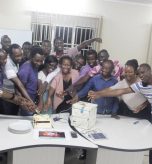
The 4th Monthly Innovation Garage successfully took place on Friday, September 25, 2015 at the RAN Lab office premises on Plot 30, Upper Kololo Terrace, Kampala Uganda. The Innovation Garage in partnership with the Innovation Consortium aids bringing innovation to life. The Garage, guided by the theme; “Catalyzing Engineering solutions” drives deep thinking by attendees through interactive brainstorm sessions and experimentation to pursue the best prototypes and solutions.
This monthly event (held every last Friday of the Month) is open to multi-disciplinary persons, students, faculty and the communities at large because at RAN, we realize and appreciate that each discipline contributes significantly to the quality of the Innovation. The Garage is a great platform to support home grown engineering solutions and through these monthly sessions RAN supports local solutions directed towards transcending nations. “We would like to see technologies developed in Africa by Africans being launched on the global market” shared Belinda Nabudde, Innovation Consortium Team Member. The Garage brings together students, faculty, researchers, scholars, innovators and the community who come together to join the radical group working on inventing game changing solutions.
This Garage hosted Power Mukisa, an Innovator from Makerere University who is developing a “Malaria Control System”. The project encompasses the use of massive ultrasound technology to effectively drive away mosquitoes from homesteads and livestock in Ugandan villages to non-inhabited places, so as to massively and effectively apply insecticides to kill the mosquitoes, reducing the spread of malaria.
The current system prototype is made of a conveyor belt, on which a spraying arm and piezoelectric material are attached and moved over a village, from one end to the other. The system emits ultrasound to drive the mosquitoes towards a given direction. When moving over uninhabited areas, the movement slows down, allowing for concentrated spray of chemicals, to kill mosquitoes and their larvae. The belt changes direction of motion when the end of the designated area is arrived at and this continues over and over again, till when stopped by an operator.
Discussions during the Garage covered the following areas of the innovation;
- The technical implementation of a whole new, more effective design, than had been earlier prototyped.
- Re-inventing the technology into an industrial Ultrasound Tower, with particular acoustic characteristics, and with knowledge on how to perform biological testing of the device.
- Issues related to what distance would the Ultrasound tower be from the house or potential mosquito habitat visa-vie the related long term health effects on humanity
- Ideas on design of the Ultrasound Tower: implementation of circuitry and finding alternative for ultrasound probe
- Design of the spraying tank and details about the required mechanism
- Integration of the entire system (control mechanisms among others)
- Can we explore using natural plants e.g. Rose Mary and Garlic as repellants?
- Avoid using repellants which will affect the entire environment but rather target the female mosquitoes.
At the end of the garage, Power Mukisa expressed his gratitude towards the efforts of the team that expanded his knowledge on how to better implement the project. He was particularly touched by the fact that some of the members went the extra mile to research about mosquitoes and ultrasound, days before the garage meeting. In his own words, he said “I am grateful for platforms such as these (the Innovation Garage), from which we get to brainstorm on projects, so that we can develop solutions to address the most pressing community challenges together.”
In his closing remarks, Byron Ssemalogo from the Innovation Consortium urged participants to maximize the Innovation Garage platform once available and accessible.













